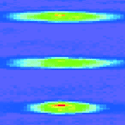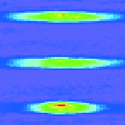Shaking atoms to make them stop
The spreading of a wave packet of cold atoms in an optical lattice is described by Bloch waves, similar to electrons in a crystalline lattice. Cold atoms in optical lattices can therefore mimic the physics of solids and they are often more manageable: the lattice is clean, tunable, and can be manipulated almost at will. For instance, one can apply a driving force that shifts the optical lattice periodically in time. Similar to a lattice that is periodic in space giving rise to a quasimomentum, a lattice that is periodic in time also introduces a quasienergy.
Writing in Physical Review A, a team of experimentalists and theoreticians from the ICFO in Barcelona, Spain, the Carl von Ossietzky Universität in Oldenburg, Germany, and the Università di Pisa in Italy show that a Bose-Einstein condensate of atoms in a shaken optical lattice gives access to a new form of quantum state engineering. The group shows they can modify the Bloch bands of the atoms in a controllable way. For a particular choice of frequency and strength of the driving force, they can make the Bloch bands completely flat, which is equivalent to making the effective mass of the atoms infinite. In this way, they can suppress the tunneling of atoms in the lattice. This represents a nice realization of “dynamical localization,” which can be viewed as the quantum analog of the classical inverted pendulum stabilized by a force that is periodic in time.
Based on the good agreement between theory and experiment and in view of the large tunability of the key parameters, the idea of quasienergy band engineering appears to be a promising tool to realize band structures that might not have an analog in traditional solid-state physics. – Franco Dalfovo





